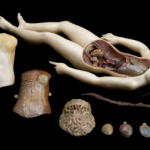History of Medicine
While "flesh-eating infections" caused by the group A streptococcus (Streptococcus pyogenes) may grab more headlines today, one hundred and fifty years ago, the best known and most dreaded form of streptococcal infection was scarlet fever. Simply hearing the name of this disease, and knowing that it was present in the community, was enough to strike fear into the hearts of those living in Victorian-era United States and Europe. This disease, even when not deadly, caused large amounts of suffering to those infected. In the worst cases, all of a family's children were killed in a matter of a…
I left off yesterday with the initial discovery of "Vero toxin," a toxin produced by E. coli (also called "Shiga toxin" or "Shiga-like toxin"). Though this may initially seem unconnected to hemolytic uremic syndrome (HUS), the discovery of this cytotoxin paved the way for a clearer understanding of the etiology of this syndrome, as well as the mechanisms by which disease progressed. By the early 1980s, several lines of research pointed toward E. coli, and particularly O157:H7, as the main cause of HUS.
A 1982 Centers for Disease Control and Prevention MMWR report found a rare E. coli…
As I mentioned yesterday, the epidemiology of hemolytic uremic syndrome (HUS) was murky for several decades after it was first defined in the literature in 1955. In the ensuing decades, HUS was associated with a number of infectious agents, leading to the general belief that it was a "multifactorial disease"--one that had components of genetics and environment, much like we think of multiple sclerosis today, for example.
Several HUS outbreaks made people think twice about that assumption, and look deeper into a potential infectious cause. A 1966 paper documented the first identified outbreak…
Next to Ebola, my favorite virus would probably be smallpox (Variola virus). I mean, now that it's eradicated in nature, what's not to love about the mysteries it's left us--where it came from, why it was so deadly (or, not so deadly, as in the emergence of the "mild" form, variola minor), and will a new poxvirus emerge to take its place? The topic is particularly germane since the debate still rages on about the fate of the world's smallpox stocks. Smallpox has killed untold millions and influenced the destiny of societies; and as Michael Willrich details in his new book, Pox: An American…
from a different Daily Dish -- 365 petri dishes, by Klari Reis
House of Wisdom, the splendid new blog on Arabic science from Mohammed Yahia, editor of Nature Middle East describes an effort to map the Red Sea's coral reefs with satellite, aerial, adn ship-based technologies. Nice project and a promising new blog.
Brain and Mind
Ritalin works by boosting dopamine levels, says a story in Technology Review, reporting on a paper in Nature Neuroscience. The effect is to enhance not just attention but the speed of learning.
As several tweeters and bloggers have noted, H-Madness is a new group blog…
Cordyceps in glass, by glass artist Wesley Fleming -- a strange depiction of a rather horrid business. For more, do go to the source, the lovely Myrmecos Blog, which is all about bugs.
Now, the best of the week's gleanings. I'm going to categorize them from here out, and at least try to keep them from being from completely all over everywhere about everything.
Mind, brain, and body (including those gene things)
While reading Wolpert's review of Greenberg's book about depression (he didn't much like it), I found that the Guardian has a particularly rich trove of writings and resources on…
Can't blog ... lost in AMAZING ARCHIVE OF MEDICAL IMAGES! Today from BoingBoing:
This previously unreported archive at the National Museum of Health and
Medicine in Washington, D.C., contains 500,000 scans of unique images
so far, with another 225,000 set to be digitized this year. Mike Rhode, the museum's head archivist, is working to make tens of
thousands of those images, which have been buried in the museum's
archive, available on Flickr. Working after hours, his team has posted
a curated selection of almost 800 photos on the service already,
without the express permission…
Below, the "jugum penis," designed to prevent "nocturnal lincontinence" (aka masturbation). One of many wonders in a new London Science Museum online exhibit of historical medical objects called "Brought to Life," as featured in this New Scientist photo essay.
Don't try these at home.
Wax anatomical figure of reclining woman, Florence, Italy, 1771-1800
Science Museum London
Starting today, the Wellcome Trust and sciencemuseum.org.uk open a brand spanking new collection of medical history archives. "Brought to Life: Exploring the History of Medicine" is searchable by people, place, thing, theme, and time. You can view a timeline of medical history in Europe next to similar timelines for the Islamic empire, Egypt and Greece (I do wish China and India were as prominently placed). You can read essays about larger questions, like what "wellness" means, or play with a cool…

